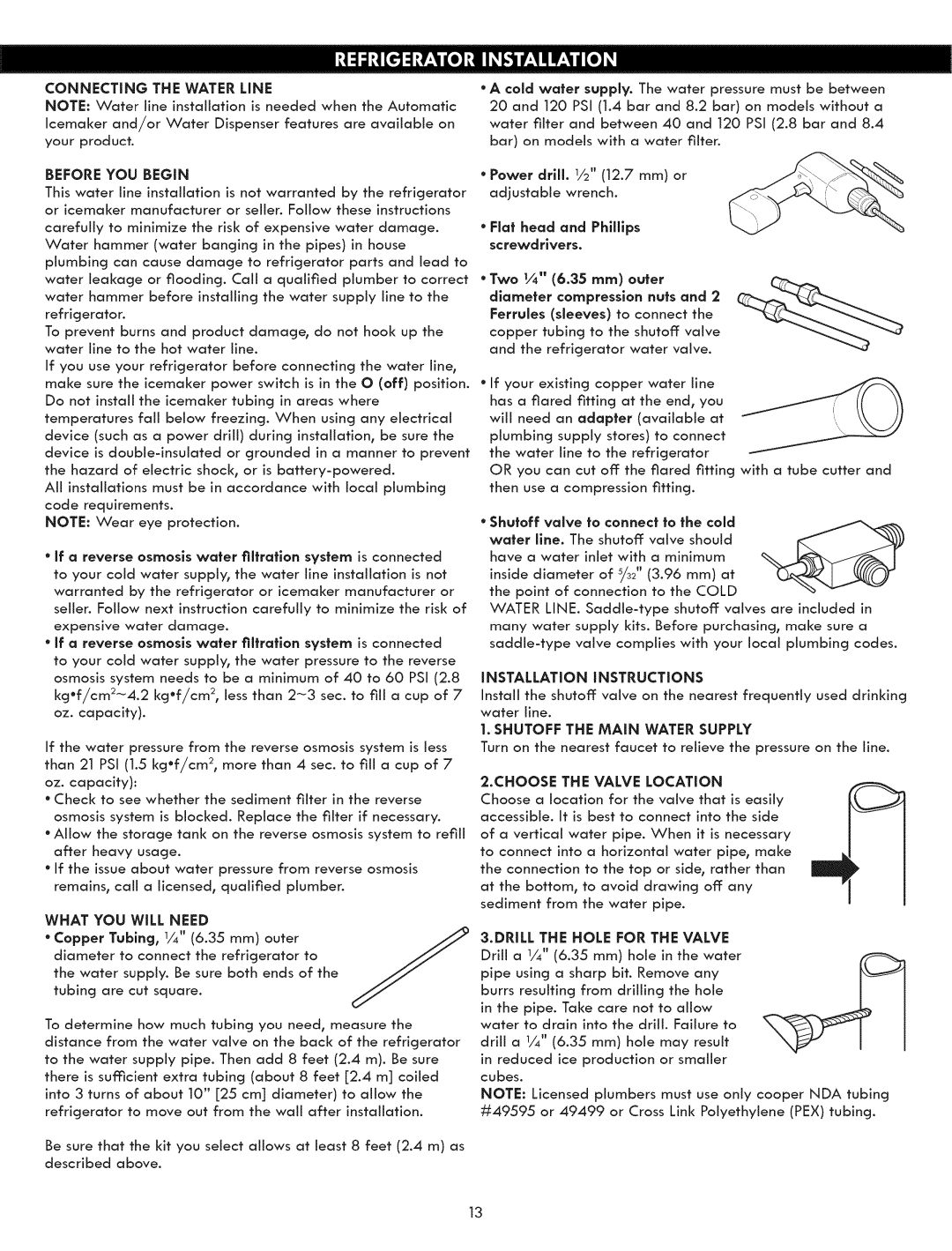
CONNECTING THE WATER LINE
NOTE: Water line installation is needed when the Automatic Icemaker and/or Water Dispenser features are available on your product.
BEFORE YOU BEGIN
This water line installation is not warranted by the refrigerator or icemaker manufacturer or selien Follow these instructions
carefully to minimize the risk of expensive water damage. Water hammer (water banging in the pipes) in house plumbing can cause damage to refrigerator parts and lead to water leakage or flooding. Caiia qualified plumber to correct water hammer before installing the water supply line to the refrigerator.
To prevent burns and product damage, do not hook up the water line to the hot water line.
If you use your refrigerator before connecting the water line, make sure the icemaker power switch is in the O (off) position. Do not install the icemaker tubing in areas where temperatures fail below freezing. When using any electrical device (such as a power drill) during installation, be sure the
device is
Aii installations must be in accordance with local plumbing code requirements.
NOTE: Wear eye protection.
*If a reverse osmosis water filtration system is connected to your cold water supply, the water line installation is not warranted by the refrigerator or icemaker manufacturer or seller. Follow next instruction carefully to minimize the risk of expensive water damage.
*if a reverse osmosis water filtratlon system is connected
to your cold water supply, the water pressure to the reverse osmosis system needs to be a minimum of 40 to 60 PSI (2.8
If the water pressure from the reverse osmosis system is less than 21 PSI (1.5 kg°f/cm 2, more than 4 sec. to fill a cup of 7 oz. capacity):
°Check to see whether the sediment filter in the reverse osmosis system is blocked. Replace the filter if necessary.
°Allow the storage tank on the reverse osmosis system to refill after heavy usage.
°If the issue about water pressure from reverse osmosis remains, call a licensed, qualified plumber.
WHAT YOU WILL NEED
*Copper Tubing, 1/4" (6.35 mm) outer diameter to connect the refrigerator to the water supply. Be sure both ends of the tubing are cut square.
To determine how much tubing you need, measure the distance from the water valve on the back of the refrigerator to the water supply pipe. Then add 8 feet (2.4 m). Be sure there is sufficient extra tubing (about 8 feet [2.4 m] coiled into 3 turns of about 10" [25 cm] diameter) to allow the refrigerator to move out from the waft after installation.
Be sure that the kit you select allows at least 8 feet (2.4 m) as described above.
°A cold water supply. The water pressure must be between 20 and 120 PSI (1.4 bar and 8.2 bar) on models without a water filter and between 40 and 120 PSI (2.8 bar and 8.4 bar) on models with a water filter.
•Power driIN. 1/2" (12.7 mm) or adjustable wrench.
*Flat head and Philllps screwdrivers.
*Two 1/4" (6.35 ram) outer
diameter compression nuts and 2
Ferrules (sleeves) to connect the copper tubing to the shutoff valve
and the refrigerator water valve.
•If your existing copper water line has a flared fitting at the end, you will need an adapter (available at plumbing supply stores) to connect the water line to the refrigerator
OR you can cut off the flared fitting with a tube cutter and then use a compression fitting.
*Shutoff valve to connect to the cold water llne. The shutoff valve should have a water inlet with a minimum inside diameter of _32" (3.96 mm) at the point of connection to the COLD
WATER LINE. Saddle=type shutoff valves are included in many water supply kits. Before purchasing, maize sure a saddle=type valve complies with your local plumbing codes.
INSTALLATION iNSTRUCTIONS
Install the shutoff valve on the nearest frequently used drinking water line.
1. SHUTOFF THE MAIN WATER SUPPLY
Turn on the nearest faucet to relieve the pressure on the line.
2.CHOOSE THE VALVE LOCATION
Choose a location for the valve that is easily accessible. It is best to connect into the side
of a vertical water pipe. When it is necessary to connect into a horizontal water pipe, maize
the connection to the top or side, rather than m at the bottom, to avoid drawing off any
sediment from the water pipe.
3.DRILL THE HOLE FOR THE VALVE Drill a 1/4" (6.35 mm) hole in the water pipe using a sharp bit. Remove any burrs resulting from drilling the hole
in the pipe. Take care not to allow water to drain into the drill. Failure to
drill a 1/4" (6.35 mm) hole may result
in reduced ice production or smaller cubes.
NOTE: Licensed plumbers must use only cooper NDA tubing #49595 or 49499 or Cross Link Polyethylene (PEX) tubing.
13
